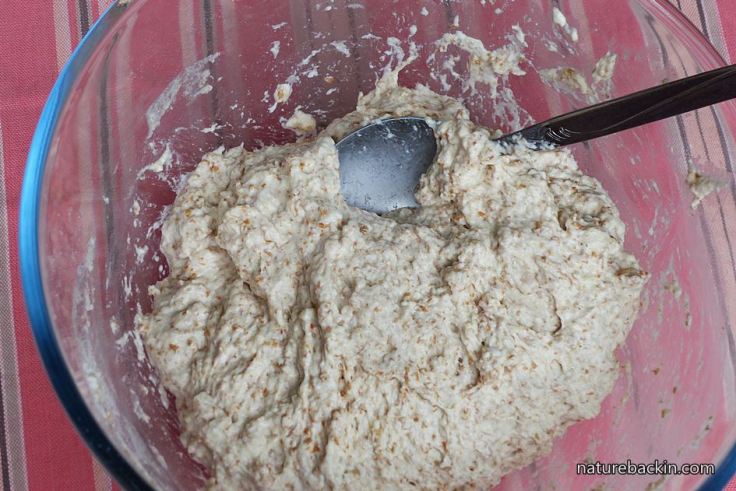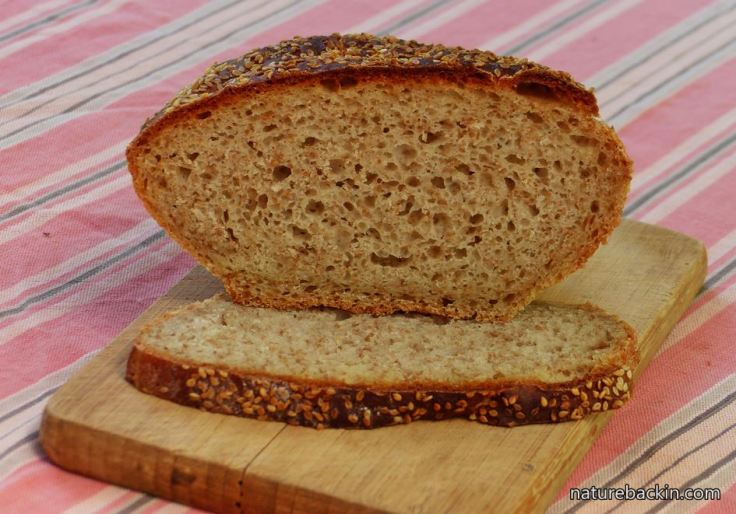For me, part of letting nature back in, is acknowledging that many of us urban dwellers have become dependent on others, even for trivial things. Our grandparents or great-grandparents were likely to have been a lot more self-sufficient and handy than many of us urbanites are today.
Bread is a staple that crosses many cultures, and many methods of making bread by hand are still practised and new methods are evolving. Making bread at home is linking up with an ancient heritage. Here is an easy recipe for those, like me, who might initially be intimidated by cooking with yeast.
I had always thought that making bread was far too complicated and demanding for me to attempt. Until I found a simple recipe in the book Quiet Food: A Recipe for Sanity, a beautifully presented book of recipes developed at the Buddhist Retreat Centre, in Ixopo, South Africa. The recipe is for a batter bread, which means you basically mix all the ingredients (including instant yeast) together, leave it to rise once in the baking tin, and then cook it in the oven. And you have bread.
Over time, I have modified the recipe, and I share with you here, how I make this bread. It is great to make when I am in a hurry. It is tasty, at least 50% whole-wheat, and far better than most supermarket bread, and you know what all the ingredients are.
Since then, via the no-knead bread route, I have moved on to making a sourdough starter and then used that to make sourdough bread. Sourdough has become a staple in our house, but it is time consuming to make and takes a bit of planning. I still use this recipe when I need to.
So here it is: a recipe for a quick, easy and tasty loaf.
These are the ingredients:
250 g whole-wheat flour (I use GMO-free stone-ground flour)
250 g white bread flour
1½ tsp salt
1½ tsp instant dry yeast
3 tsp sugar or honey
1½ Tablespoons oil or melted butter (I use olive oil)
450 mls/450 g lukewarm water
Oven temperature is 180 degrees Celsius.
Use a higher proportion of whole-wheat to white bread flour if you prefer.

Mix all the dry ingredients together in a large bowl.

Add the oil and water.

Mix it all up with a metal tablespoon. The mixture is wet and tacky. Don’t attempt to use a mixer or dough hooks or even your hands – I speak from unhappy and messy experience on this aspect. Use the stickiness to your advantage and get the dough to cohere to itself, rather than to anything else! To develop the gluten a bit, I do several “stretch and folds”. That is I use the spoon to lift the dough and stretch it a bit and then drop it, turn the bowl a bit, and repeat that six-to-ten times.
Then tip and scrape the dough into the bread pan. I use a silicon baking tin that is approximately 21 cm long and about 11 cm wide. A metal pan will be fine to use too.
Leave the pan in a warm spot for the bread to rise to about double its size. Keep it covered. I place an empty bread pan upside down over the top. Depending on the ambient temperature, rise the dough in the pan for about 45 minutes to an hour. The cooler it is the longer the rise. Preheat the oven to 180 degrees Celsius so that it is up to temperature by the time the dough has risen.

You can mix a few seeds into the dough, or once the dough is tipped into a baking pan, you can sprinkle some seeds on top. I have used sesame seeds here. I have also used sunflower seeds and also added linseeds that I ground just before adding.
The above picture is taken after the dough has risen and it is ready to go into the oven.
Bake the loaf for 1 hour at 180 degrees C.
Once done, remove from the pan and cool on a rack.

Leave it to cool for about an hour before slicing and eating! This bread is best eaten on the day it is baked, but it acceptable on the following day and makes lovely toast.

And here it is sliced. Not a bad “crumb” for a batter bread.
Perhaps one day, I will share how I learnt to make sourdough starter, and the method I use to make a lovely sourdough boule.
In the meantime, bon appetit!
I had not thought that watching bread making videos could be entertaining, and probably most aren’t, but this one, on recreating bread to match a loaf found in the volcanic ash in the ruins of Herculaneum that was destroyed along with Pompeii by the eruption of Mount Vesuvius in 79 AD is definitely entertaining. It is produced by the British Museum and features the chef Giorgio Locatelli making the 2000-year old bread . Find it here
Posted by Carol









June 30, 2017 at 3:29 pm
When in the US I make all our bread because the price of a loaf of anything halfway decent is horribly expensive. Here in France where it is ‘the right of every man to eat fresh bread daily’ I can get a beauteous baguette for loose change. Both baking and boulangering are amongst my Favourite things to do! This is a lovely post and I hope it inspires many to bake because it is not at all hard to achieve such great satisfaction
LikeLiked by 1 person
June 30, 2017 at 5:54 pm
I can quite understand why you need to bake when in the US and not at all when in France. If we had access to a decent bakery i wouldn’t bake myself, but it is true that making even a half decent loaf is very satisfying. And eating and sharing it even more so 🙂
LikeLiked by 1 person
July 1, 2017 at 1:33 pm
I find bread baking very therapeutic 🙂
LikeLiked by 1 person
June 30, 2017 at 12:12 pm
I too have been put off by the thought of all that kneading and waiting and kneading and waiting. This recipe looks worth trying out – thank you!
LikeLiked by 1 person
June 30, 2017 at 5:47 pm
It’s definitely worth a try. I hope you like it.
LikeLike
June 30, 2017 at 6:44 am
…’becomes’, even ……
LikeLike
June 30, 2017 at 5:46 pm
Got it! 🙂
LikeLiked by 1 person
June 30, 2017 at 6:44 am
No knead bread. Well, I’ll definitely give this a try. And I must get back to cultivating a sourdough starter. I used to do it, but got out of the habit, and now we’re away quite often, it becomns harder, as it does need parenting!
LikeLiked by 1 person
June 30, 2017 at 5:44 pm
I meant to say something more about no knead bread (as opposed to batter bread) but was a bit pushed for time. But for more on the real deal no knead bread, just Google “Jim Lahey no knead bread” and then watch the NYT video. I used to make it a lot before getting into the sourdough thing, which is all about habit as you say. I keep a jar of starter on the counter that I feed everyday, and a backup in the fridge that I feed about every 10 days. I kept a well-fed stash in the fridge for over three weeks when we were away, fed it when we got back and it was fine. My starter is now about 2 years old. I hope you are able to get back into the habit before too long.
LikeLiked by 1 person
June 30, 2017 at 6:53 pm
Oooh, thanks for all those tips. No excuses now …..
LikeLiked by 1 person
June 30, 2017 at 6:27 am
Along with freshly brewed coffee of course 🙂
LikeLike
June 30, 2017 at 2:34 am
Admirable patience to make bread this way. Dr C and I make one small loaf every day overnight using a bread making machine. Not as classy as yourself, but it’s just finishing at 6am every day as I come downstairs to make tea, wonderful smell! Nice post!
LikeLiked by 1 person
June 30, 2017 at 6:37 am
Thanks Dr B. How lovely to be greeted by the smell of freshly baked bread in the morning!
LikeLiked by 1 person
June 30, 2017 at 6:40 am
Time for toast here now!
LikeLiked by 1 person
June 30, 2017 at 2:04 am
The smell of fresh-baked bread… it’s the best!
LikeLiked by 2 people
June 30, 2017 at 6:34 am
Thanks Eliza. Somehow my above comment in praise also of the smell of fresh coffee didn’t get put into the thread. I hope that this one threads correctly.
LikeLiked by 1 person